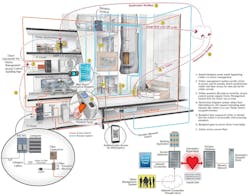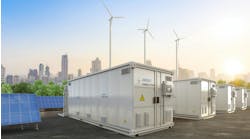Editor's note: This is part 1 of a two-part series. Read part 2 next.
More and more clients are moving to destination dispatch (DD) systems, including new building projects and, more commonly, lobby renovations, which is probably where we will see much more of this elevator technology in the future.
The key questions we’ll be exploring throughout this article are: what is a destination dispatch system, why are property managers converting, and why is the future trending towards more frequent and significant lobby renovations that will involve DD?
DD systems reinvent how elevators are accessed, and the primary benefit to the user is speed and convenience. DD systems are direct, floor-to-floor systems, eliminating the time spent waiting through a series of floor stops. Existing elevators are predominantly based on inputs and mechanical relays that wear out. Diagnosing failed relays is a major maintenance item and takes significant time to complete. Newer systems monitor and control status, ease of maintenance, lower maintenance costs, and reduce downtime.
Buildings with heavily used 15- to 20-year-old elevator systems will probably need an overhaul due to relays reaching the end of their life, and their associated parts being “sunset.” Sunsetting refers to when a manufacturer no longer supports or manufactures parts for a system – forcing them to direct customers to an e-commerce website such as eBay, where decommissioned systems and parts are sold as-is at inflated prices.
Moving to DD systems has other significant benefits – reduced equipment and space needed to house the new equipment. With the removal of inputs and relays, many of the storage cabinets are no longer required. Direct current (DC), low-voltage systems coupled with the reduction of electronics and cabinets, allows for improved energy efficiency.
These alone are compelling reasons for a migration, yet an added reason is less user “friction” and frustration when a tenant visitor has to endure a child’s antics. For example: The child riding within a traditional elevator presses all the floor buttons before walking off the cab on to a floor. As they look back, their smirk is the prelude to a lengthy floor by floor progression until the destination floor is reached—but not with DD. There are no floor indicator buttons, the elevator expresses to a specific floor, and then idles in the middle of the building or goes to the next floor call.
How Do Destination Dispatch Systems Benefit Security?
With over 20 years of security consulting and 15 years of surreptitious building entries, I have found many ways to compromise traditional relay-based elevator security. The simplest way to circumvent elevator security is through a method called “floor surfing.” This is where I access a parked elevator at grade and wait. At some point, the elevator is called from a floor above, and I would ride in that elevator until I could access the floor I wanted.
Sometimes I became impatient, would exit, and recall an elevator from that floor – steadily moving up the tower as elevators typically park in the middle of the building. This vulnerability works for me, because it is common to pick up and drop off the same people in an elevator system, and, sometimes I could ride around for hours with no one being the wiser.
This is not the case with a DD system. The elevator expresses to a specific floor. I must exit, to avoid suspicion from the next person who called the elevator. However, when I exit, I can’t simply call an elevator. I must enter my floor on a fancy and expensive kiosk, which only gives access to an amenity or lobby. With a properly designed DD system, floors outside of the tenant’s floor range need to be accessed with an access control card or code that a building tenant, engineer, or security officer holds.
In the future – advances in micro-motion radar Light Detection and Ranging (LIDAR); movement detection, heartbeat, and breathing surveillance and analytics will make it even less likely for people to “floor surf” because the elevator cab will signal an alarm when it's parked and people are in the cab.
Besides security benefits, DD systems open up opportunities for convenience. Imagine a completely frictionless environment for you as a visitor. They know when you arrive, and seemingly autonomously authenticate and notify your recipient that you are on your way up. Security can refer to you by your first name, offering a unique and personal experience. Every client I meet wants to have this functionality, integrating seamlessly with the access control system.
[Related: 3 Ways to Know It’s Time for Elevator Maintenance]
Potential Problems
Owners need to gather a wealth of information – such as how the DD system integrates with their access control system to ensure it’s the appropriate decision. The problem, however, is some DD salespeople assure the owner falsely regarding integration – afraid of the loss of a million-dollar sale and personal commission.
Salespeople with little technological training are dangerous. They push the complex discussions down the road until it’s slamming all parties in the face. The promises of what could be are resoundingly responded by installers mumbling “What was our salesperson thinking?”
The next issue relates to the nuances between the words “integrate” and “integration.” Many sales people overuse these words, and for those who do not have technical knowledge, the jargon can create a false sense of security. For those who are technologically in the know, it opens up the possibilities to Pandora’s Box.
I think many believe that the integration terminology is akin to Dictionary.com’s definition, which is “an act or instance of combining into an integral whole.” However, these words mean different things to different people. If you get to the point where you are arguing integration semantics the damage is done, and any leverage had is now gone. Examples of what could go wrong include:
The power of DD systems is superseded by the integration with the access control (security) system. Here, DD kiosks do not truly control access to a floor. For instance, some DD systems only control access by floor, not by time or date. Without another entry control device (turnstile, door, or related), access to the kiosk would afford someone unfettered access to floors that are outside their access level.
In another example, if the network connection from the access control system to the DD system is lost, then the DD system could revert to an open floor status, allowing access to any floor. Worse, there may be no alarm that the connection is severed, beyond a tenant who says to the landlord “I can access our VIP floor. I don’t think I am supposed to do that.”
How Integration Should Work
Properly implemented, systems integration can be powerful. There are some really exciting things that can be done within a Class A office building. We can fully control access; integrate DD systems into turnstiles; use Bluetooth beacons for active visitor management; use apps, mobile contactless credentials or onetime QR codes as credentials; and communicate with security and tenants when their visitors arrive and are on their way up to a floor.
Mobile platforms permit the possibility of building-wide integration, automate mechanical systems based on the presence of individuals, notify when someone does not belong in a specific area, and secure vertical access to the building. Technology can empower awareness and facilitate services by answering questions such as: “Can I help you?” and “Who are you here to see?”
The advancement of DD systems holds the promise for advancements in convenience and the possibilities of better vertical security. Next month, we will delve into the delivery of these systems and describe the steps towards this integration between two case studies that are integrating DD, access control, and visitor management for a secure and frictionless entry experience.
About the Author:
Sean Ahrens is the security market group leader for Affiliated Engineers and a member of the BUILDINGS advisory board.
Read next: Destination Dispatch Features You Need




